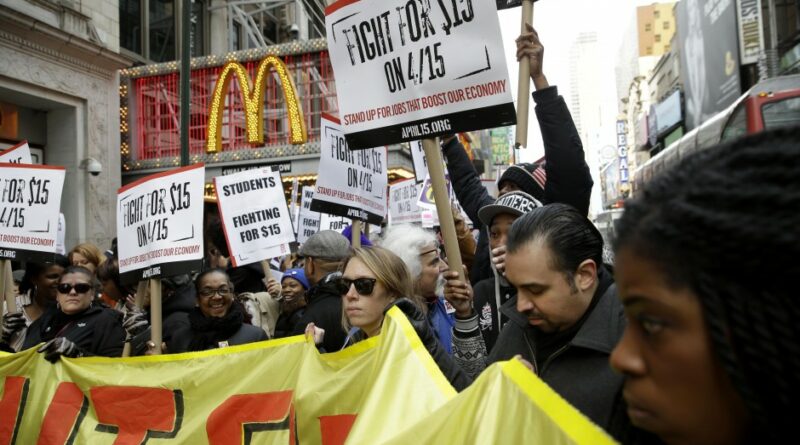The Effect of Minimum Wage on Employment
There has been a heated debate among economic scholars on issues concerning the effect of minimum wage on employment. In efforts to prove the point of their arguments, many scholars have conducted researches on the impact of increasing the minimum wage rates on the levels of employment. In this report, the author seeks to evaluate arguments of different economists on the subject based on their respective researches and the rationale behind the same.
Wage Rate and Employment
Traditionally, it has been known in economic scope that the most direct effect of implementing minimum wage policies is increased rates of unemployment among the youth and unskilled workers. The main proponents and opponents of implementing the minimum wages are the supply-side and demand-side economists. Whereas the supply-side economists argue that increasing the minimum wage-rate will lead to an increase in unemployment rate, their demand-side opponents claim that a rise in the minimum wage rate will lower the poverty levels and reduce underemployment levels.
In a comprehensive review of literature on the effects of minimum wages on employment, Neumark and Wascher (2007) report that almost two-thirds of the entries they examined indicated a negative relationship between employment and minimum wage rate. This complies with the traditional view that increases in minimum wage rate reduces employment rate among the low-wage workers. The writers attribute this relationship to the long panel studies conducted by these researchers which incorporate both state and time variations in the minimum wage. either zero or positive effect of minimum wage on low-skill employment used short panel data (Neumark and Wascher, 2007). This analysis might have been conducted within a very short period of time. This time is not sufficient to capture the full effects of wage changes, since a reasonable time is required in order to experience total adjustment of the production process on the economics of low-skilled labor.
A study was conducted by David Card and Alan Krueger (1994) on the effects of minimum wage on employment in New Jersey. The study was carried out in the fast food industry in New Jersey, with the same in Pennsylvania acting as a control group. The outcome of the analysis was contrary to the generally known relationship between the minimum wage rate and employment. Card and Krueger reported that there was no evidence that the rise in the minimum wage rates in New Jersey resulted to a reduced employment at fast food restaurants in the state. The team concluded that the increase in the minimum wage rate to $5.00 per hour in New Jersey did not lead to reduced employment, but rather the effect was transmitted to consumers through increase food prices leading to, in fact, an increase in the new number of employees hired. During the reevaluation of these findings, there were discrepancies found in the data and analysis from Card and Krueger’s study. Neumark and Wascher (2003), examined the findings ad conducted a new survey to ascertain the validity of the contra arguments. This reevaluation study was conducted using payroll records from the same fast-food stores in New Jersey with their Pennsylvanian counterparts acting as control group. It was established that the Card and Krueger’s study relied heavily on telephone information provided by the fast-food restaurants managers. The new findings by Neumark and Wascher indicated that the increase in minimum wage in New Jersey led to a decrease in fast-food employment relative to the control, group in Pennsylvania.
The law of demand states that at higher prices, less of a commodity is demanded. This law applies to any item that is required including food, cars and labor. Since a legislated increase in the cost of labor does not increase labor productivity per se, those workers who are less productive will be forced out of work. The experiment carried using the payroll data generally indicates a reverse relationship between minimum wage and labor demand (Campo, 2010). Minimum wage laws will always harm young adults at work places since they have minimal work experience and are involved in jobs that require fewer skills. A doubt is therefore cast on validity of the survey that Card and Krueger conducted “over the telephone”. The information that was provided by fast-food restaurant owners must have meant to paint a positive image of the company and therefore a marketing gimmick. The law of demand and supply is static and therefore only provisions of assumptions can be applied to indicate a positive relationship between demand and supply. It is therefore difficult to explain that an increase in the levels of wage rate will lead to increased employment. In other words, this scenario will imply that when the cost of production is increased (marked by increase in wage rates), producers or manufacturers will demand more labor for production. This is practically not realistic.
Conclusion
In conclusion, in a free labor market, the applied wage rates are determined by the forces of demand and supply. This means that, the prevailing wage rate echoes the willingness of workers to supply labor (work) and the willingness of employers to demand labor (hire the employees). The productivity of laborers will therefore determine how much the employers are willing to pay or increase the wage rate. Induced increase of wage rates characterized by legislative actions of the state of federal government will cause friction in the labor market. Meaning that, there will be employee lay-offs by companies in order to reduce the cost of production.
References
Borjas, G. (1987). Self Selection and the Earnings of Immigrant. The American Economic Review, Vol. 77, no. 4, pp. 18-20.
Campo, A. (2010, May 13) Why Americans think (wrongly) that illegal immigrants Hurt the economy. The Daily Beast.
Card, D. and Krueger, A.B. (1994). Minimum Wages and employment: A case study of the fast-food industry in New Jersey and Pennsylvania. The American Economic Review, Vol. 84, No. 4, pp. 772-793.
Card, D. and Krueger, A.B. (2000). Minimum Wages and Employment: A Case Study of the Fast-Food Industry in New Jersey and Pennsylvania: Reply. The American Economic Review, Vol. 90, No. 5, pp. 1397-1420.
Neumark, D. and Wascher, W. (2000). Minimum Wages and Employment: A Case Study of the Fast-Food Industry in New Jersey and Pennsylvania: Comment. The American Economic Review, Vol. 90, No. 5, pp. 1362-1396.
Neumark, D. and Wascher, W. (2007). Minimum Wage and Employment. IZA Discussion paper, no. 2570.
The Economist. (2011, Aug 27).Immigration: Let them Come, The West Should be More Welcoming to Migrants-There’s Compensation from The East for Them. The Print Edition.




